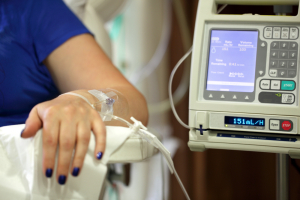In stage I and II treatment of Hodgkin’s disease consists of local radiation, which can abort Hodgkin’s disease with very good long-term survival rates. Stage III and IV needs quite sophisticated multi drug chemotherapy followed often by radiotherapy. At present the best combination seems to be doxorubicin, bleomycin, vinblastine and dacarbazine. There are differences, as mentioned earlier, depending on the cell type and the stage that the lymphoma is in at the time of diagnosis. Here is a survival table for a low-grade Hodgkin’s disease:
Survival of patients with low-grade Hodgkin’s disease
| Stage: | 5 years | 10 years | 15 years |
| I and II | 85% | 70% | 40% |
| III and IV | 75% | 55% | 25-35% |
Note: Patients in the table above were only treated with radiotherapy for stage I and II. Stage III and IV patients of these patients with low-grade Hodgkin’s disease were first treated with combination chemotherapy and then with radiotherapy, if indicated.
Patients who do not respond with a complete remission or who relapse within 6 to 12 months following initial chemotherapy, have a very poor prognosis.
The only hope for long-term survival then is a bone marrow transplantation. In selected patients, who will withstand the initial high chemotherapy dosage to wipe out the Hodgkin’s cells in the system, a bone marrow transplantation can yield cure rates in more than 50% of patients. Unfortunately not every patient with a poor prognosis will be eligible for this vigorous therapy.
References:
1. N Engl J Med 329(14):987-994,1997.
2. The Merck Manual of Diagnosis and Therapy. 17th edition, editors M.Beers and R.Berkow. Whitehouse Station, N.J., 1999.
3. Cancer: Principles & Practice of Oncology. 4th edition, edited by V.T. DeVita et al., Lippincott Co., Philadelphia, 1993. Chapters 51 and 52.
4. Cancer: Principles&Practice of Oncology. 5th edition, volume 2. Edited by Vincent T. DeVita, Jr. et al. Lippincott-Raven Publ., Philadelphia,PA, 1997. Chapter 44,Lymphomas.
5. HY Dong et al. Mod Pathol 2001 May;14(5):472-481.
6. NL Kobrinsky et al. J Clin Oncol 2001 May 1;19(9):2390-2396.
7. Conn’s Current Therapy 2004, 56th ed., Copyright © 2004 Elsevier
8. Ferri: Ferri’s Clinical Advisor: Instant Diagnosis and Treatment, 2004 ed., Copyright © 2004 Mosby, Inc







